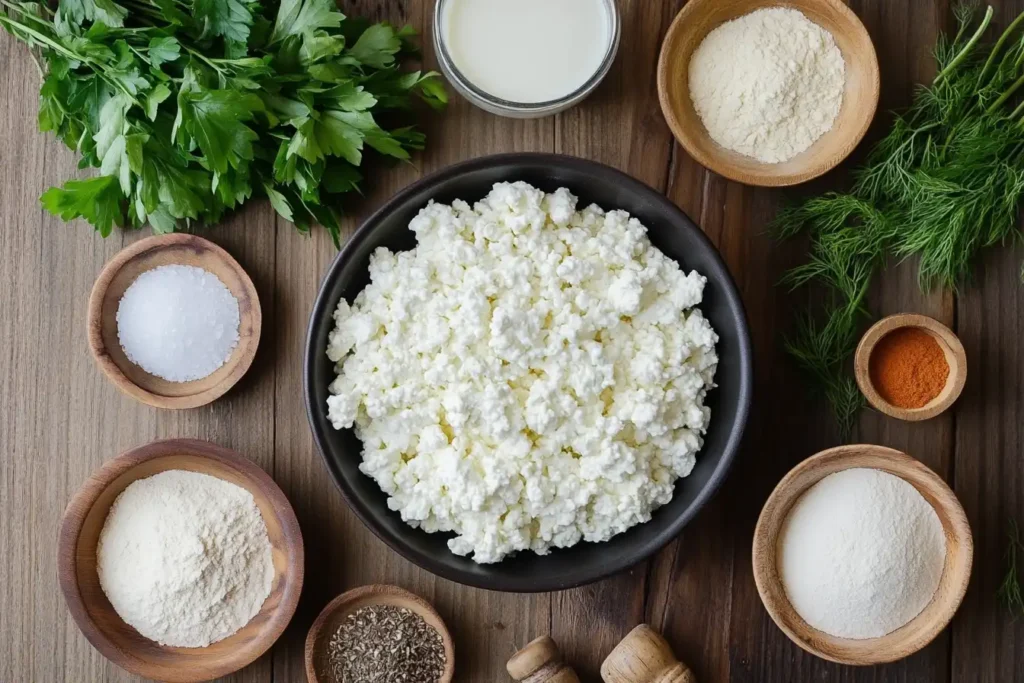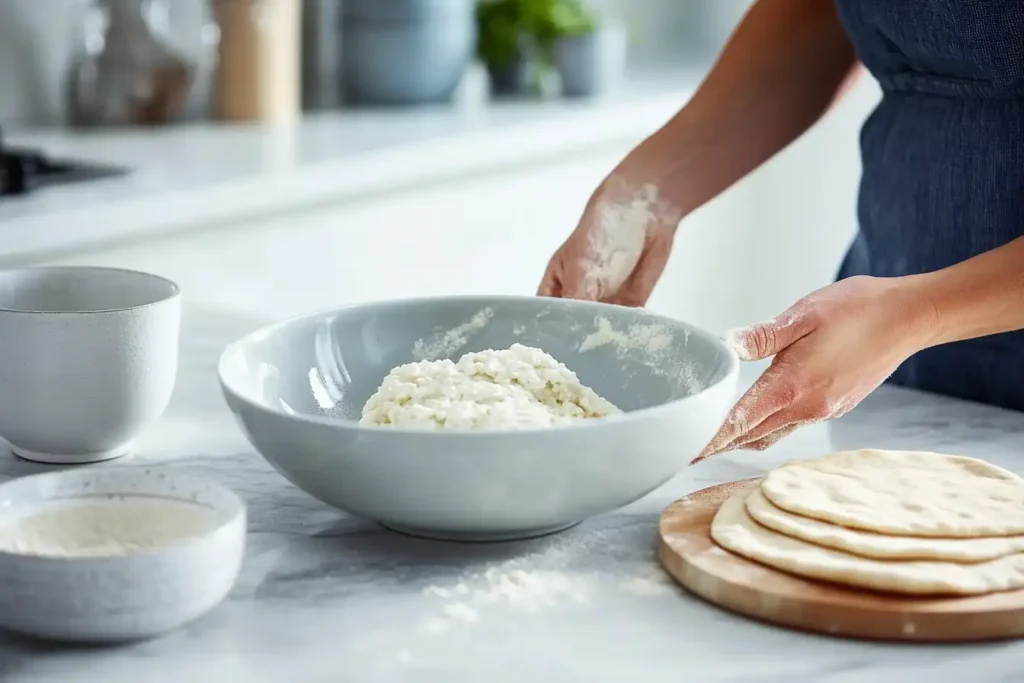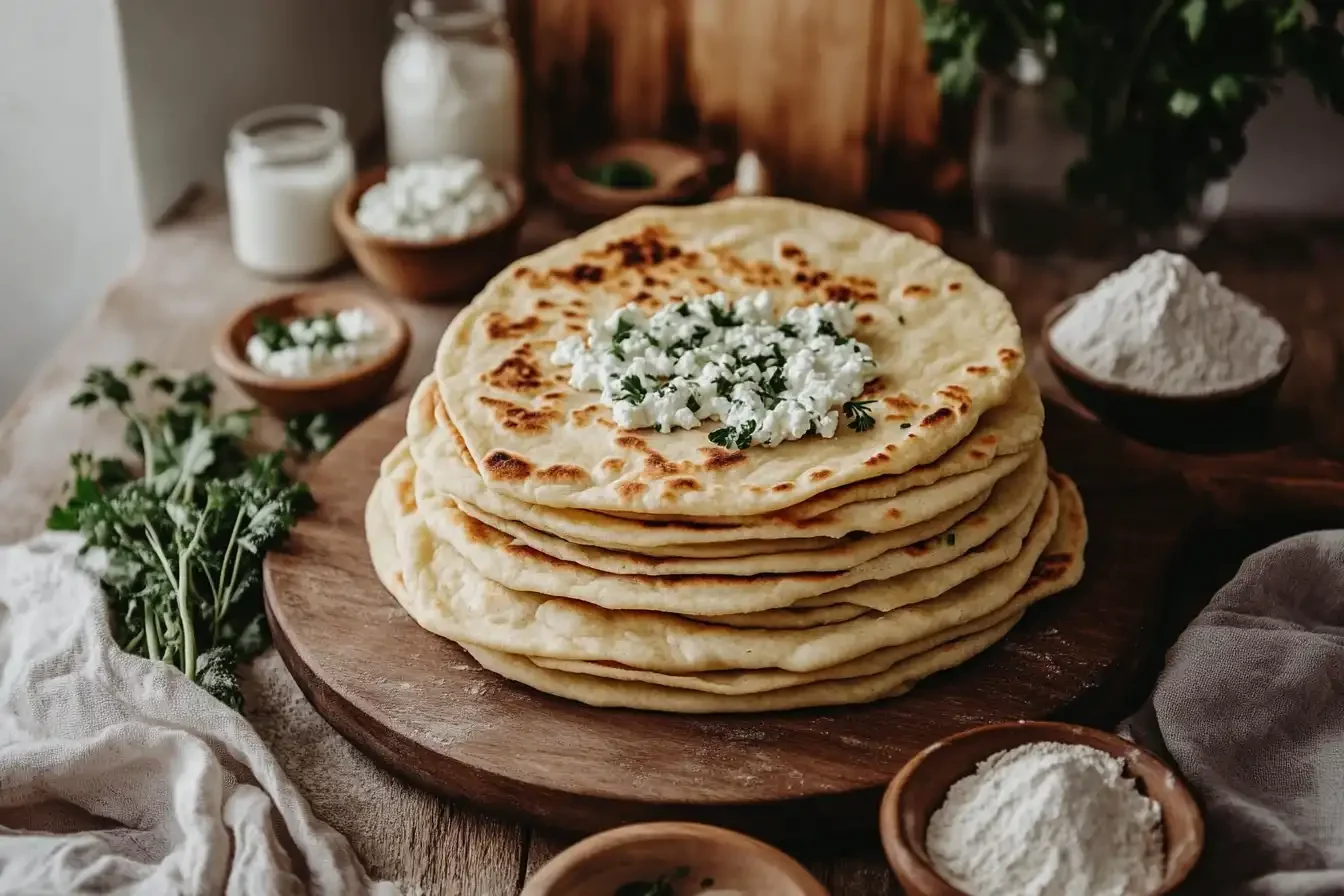Introducing a wholesome, protein-packed flatbread that satisfies cravings while nourishing your body. Cottage cheese flatbread combines the creamy richness of cottage cheese with the simplicity of flatbread, creating a dish that’s both flavorful and versatile. This article will delve into everything you need to know about this delightful recipe—from its origins and nutritional perks to step-by-step preparation methods and exciting variations. Whether you’re looking for a healthy alternative to traditional breads or simply want to try something new, this guide has got you covered.
Introduction to Cottage Cheese Flatbread
What Is Cottage Cheese Flatbread?
Flatbread, in its simplest form, is one of the oldest types of bread, made from basic ingredients like flour, water, and sometimes leavening agents. It’s a versatile base for meals, snacks, or wraps. But when cottage cheese takes center stage, flatbread transforms into something truly unique. The soft, slightly tangy cheese brings richness, moisture, and a punch of protein to the dough, elevating a simple recipe into a culinary masterpiece.
Unlike traditional flatbreads that often rely solely on flour for structure, cottage cheese flatbread incorporates this nutritious ingredient to create a softer texture and richer flavor. It’s a great option for those looking to boost their protein intake without sacrificing taste or convenience. With its natural creaminess, cottage cheese acts as both a flavor enhancer and a binding agent, ensuring every bite is tender and satisfying.
This flatbread is more than just delicious—it’s incredibly versatile. Use it as a pizza base, pair it with dips, or enjoy it on its own as a snack. The possibilities are endless!
The Popularity of Cottage Cheese Flatbread
Why is cottage cheese flatbread becoming a crowd favorite? To begin with, it fits well with modern food trends focusing on healthy choices. In addition, as more people look for options instead of heavy breads, recipes like this one clearly meet the need. Packed with protein and made with simple, healthy ingredients, it appeals to those following high-protein diets, vegetarians, and even picky eaters looking for creative ways to add more good stuff to their meals.
Moreover, its quick and easy preparation makes it perfect for busy lives. Whether you’re making breakfast or putting together a fast dinner, cottage cheese flatbread offers ease without losing its goodness. Plus, its flexibility allows it to fit smoothly into different food styles and meal plans, making it a must-try for home cooks everywhere.
Nutritional Benefits of Cottage Cheese in Flatbread
Cottage cheese isn’t just a tasty part of the recipe—it’s full of good nutrients. Packed with high-protein content, calcium, and important vitamins like B12, it’s perfect for giving your body energy. When added to flatbread, it improves the dish with its creamy texture and strong nutritional benefits.
One of the standout benefits of cottage cheese is its protein content. A single serving can provide over 10 grams of protein, which is vital for muscle repair and growth. Additionally, it’s a low-fat option, making it ideal for those watching their calorie intake. The calcium in cottage cheese supports bone health, while its probiotics promote gut health, making this ingredient a win-win for overall wellness.
Compared to traditional flatbreads that may lack enough nutrition, cottage cheese flatbread stands out. Its combination of carbs and protein not only ensures steady energy, but also makes it a smart choice for breakfast or after-exercise snacks. Also, it’s highly flexible—you can easily add whole-wheat flours or gluten-free options to suit different food needs while still keeping the taste and texture.
Preparing Cottage Cheese Flatbread
Ingredients Needed for Cottage Cheese Flatbread

To prepare cottage cheese flatbread, you only need a handful of simple ingredients, many of which are pantry staples. The main ingredients include:
- Cottage cheese: The star of the recipe, providing creaminess and a high-protein boost.
- All-purpose flour or whole-wheat flour: Acts as the base for the dough, giving it structure and texture.
- Plain yogurt: Adds tanginess and moisture to the dough, helping bind the ingredients together.
- Salt and seasoning: Enhances the flavor of the flatbread, with options like garlic powder or dried herbs for extra zest.
For variations, consider these optional ingredients:
- Fresh herbs (e.g., parsley, dill): For a burst of flavor and freshness.
- Spices (e.g., cumin, paprika): To add warmth and depth to your flatbread.
- Shredded vegetables (e.g., spinach, zucchini): To boost the nutritional profile.
Each ingredient plays a crucial role. Cottage cheese ensures a soft and tender texture, while yogurt keeps the dough pliable and easy to work with. Flour provides the foundation, and seasonings add a personalized touch. Together, they create a well-balanced base for customization.
Step-by-Step Recipe for Cottage Cheese Flatbread

Here’s a foolproof method to make your own cottage cheese flatbread:
1. Combine the ingredients:
In a large mixing bowl, combine 1 cup of cottage cheese, 1 ½ cups of flour, ¼ cup of yogurt, and a pinch of salt. Mix until a dough forms. If the dough feels too sticky, add more flour gradually, 1 tablespoon at a time.
2. Knead the dough:
Transfer the dough onto a floured surface and knead for about 5-7 minutes until it becomes smooth and elastic. Be careful not to over-knead, as this could make the flatbread tough.
3. Divide and roll out:
Divide the dough into small balls (about 4-6, depending on your preferred size). Roll each ball into a flat disc, approximately ¼ inch thick, on a floured surface.
4. Cook your flatbread:
- Stovetop method: Heat a non-stick skillet over medium heat. Cook each flatbread for 2-3 minutes on one side until bubbles form, then flip and cook for another 2 minutes.
- Baking method: Preheat the oven to 375°F (190°C). Place flatbreads on a baking sheet lined with parchment paper and bake for 8-10 minutes, flipping halfway through.
Pro Tips:
- Use a light dusting of flour while rolling to prevent sticking.
- Ensure the skillet or oven is preheated to avoid uneven cooking.
- Brushing the flatbread with olive oil or melted butter post-cooking adds an irresistible golden sheen.
Customizing Your Cottage Cheese Flatbread
The beauty of cottage cheese flatbread lies in its adaptability. Here are some ideas for personalizing your flatbread to suit different tastes:
Add-ins for Extra Flavor:
- Toss in chopped fresh herbs like cilantro, parsley, or dill for a garden-fresh twist.
- Sprinkle in spices like cumin, chili flakes, or smoked paprika to give your flatbread a unique kick.
- Mix shredded vegetables like spinach or grated carrots into the dough for added nutrition and color.
Dietary Adjustments:
- Gluten-free option: Replace regular flour with a gluten-free blend or almond flour. Add a pinch of xanthan gum for elasticity.
- Vegan alternative: Swap cottage cheese with vegan cream cheese or tofu blended with lemon juice, and replace yogurt with plant-based yogurt.
Pairing Ideas:
- Serve with hummus, tzatziki, or avocado dip for a creamy, flavorful side.
- Use it as a wrap for grilled vegetables or lean protein.
- Top with scrambled eggs or smoked salmon for a high-protein breakfast.
With these options, you can make your cottage cheese flatbread truly your own, turning a simple recipe into a flavorful masterpiece.
Looking for more creative ways to use cottage cheese? Try this delicious and easy recipe for Cottage Cheese Cookie Dough to satisfy your sweet cravings while staying healthy!
Variations and Serving Ideas
Different Styles of Cottage Cheese Flatbread
Cottage cheese flatbread is incredibly versatile, lending itself to a range of styles and textures. Whether you prefer a thin, crispy crust or a soft, pillowy base, there’s a version for everyone.
Thin-crust vs. thick-crust flatbread:
- A thin-crust cottage cheese flatbread is perfect for lighter meals or as a crispy snack. Roll the dough thinly and bake it until golden, creating a cracker-like texture that pairs well with dips and spreads.
- A thick-crust flatbread, on the other hand, is heartier and more filling. Roll the dough thicker and bake it slightly longer to achieve a soft, bread-like consistency ideal for hearty toppings.
Cottage cheese naan and pita alternatives:
Cottage cheese can easily be incorporated into naan-style or pita-style flatbreads. Additionally, these variations are slightly fluffier and therefore make excellent companions to curries, stews, or grilled dishes.
Regional takes on cottage cheese flatbread:
Many cultures have their own spin on flatbread, and adding cottage cheese elevates these traditional recipes. For instance:
- Middle Eastern manakish with za’atar seasoning gains a protein boost from cottage cheese.
- Italian-inspired flatbreads topped with herbs and olive oil can include cottage cheese for a creamy twist.
- Indian flatbreads like parathas are enriched with cottage cheese for a fusion-style dish.
Cottage Cheese Flatbread as a Meal Component
This flatbread’s versatility makes it a fantastic addition to any meal, regardless of the time of day.

Using it as a base for wraps and sandwiches:
Roll your flatbread around grilled vegetables, falafel, or lean meats for a wholesome wrap. It also works well as a substitute for tortillas in quesadillas or burritos.
Pairing with soups, salads, and curries:
Serve cottage cheese flatbread alongside hearty soups like tomato bisque or lentil stew for a comforting meal. Its mild flavor also complements fresh salads and rich curries, soaking up all the delicious sauces.
Ideas for breakfast, lunch, and dinner dishes:
- Breakfast: Spread with avocado and a sprinkle of chili flakes for a quick, nutritious start to your day.
- Lunch: Top with cottage cheese and fresh veggies like cherry tomatoes, cucumber, and sprouts for an open-faced sandwich.
- Dinner: Use it as a pizza base, layering with marinara, mozzarella, and your favorite toppings.
This flatbread easily works for any meal, showing it’s not just useful but a must-have in the kitchen.
Tips for Storing and Reheating Cottage Cheese Flatbread
To keep your cottage cheese flatbread fresh and ready to enjoy, follow these simple storage and reheating tips.
Proper storage methods for keeping flatbreads fresh:
Once cooled, wrap your flatbreads tightly in foil or plastic wrap to keep them moist. For short-term storage, put them in a sealed container at room temperature for up to 2 days.
Best ways to reheat flatbread while preserving texture:
- For a soft and warm texture, wrap the flatbread in foil and heat it in the oven at 350°F (175°C) for 5-7 minutes.
- If you prefer a crispy edge, reheat it on a skillet over medium heat for 1-2 minutes per side.
Freezing options for longer shelf life:
Flatbreads freeze very well. Place each flatbread between baking paper to stop them from sticking, then put them in a sealed freezer bag. Freeze for up to 2 months. When you’re ready to eat, let the flatbread soften at room temperature before warming it up.
Following these tips ensures your flatbreads remain just as delicious as when they were freshly made. Up next, we’ll answer common questions and address potential challenges in making this recipe!
FAQs and Troubleshooting
Frequently Asked Questions About Cottage Cheese Flatbread
Why is my cottage cheese flatbread soggy?
Sogginess in flatbread often happens because of too much water in the dough or not cooking it enough. To fix this, make sure you fully drain the cottage cheese before mixing it into the dough. Also, don’t crowd the cooking surface, as this can trap steam and make the flatbread soft and limp.
How long does cottage cheese flatbread last?
Cottage cheese flatbread can last up to 2 days when kept at room temperature in a sealed container. For longer storage, keep it in the fridge for up to 5 days or freeze it for up to 2 months. Make sure it’s well-covered to stay fresh.
Does cottage cheese melt like cheese?
Unlike harder cheeses, cottage cheese doesn’t melt into a gooey texture. Instead, it softens and blends with other ingredients, creating a creamy, slightly tangy flavor profile.
How to keep cottage cheese flatbread from sticking?
Dust your rolling surface and hands with flour before shaping the dough. For cooking, preheat your skillet or baking sheet thoroughly and lightly grease it to prevent sticking.
How do you remove moisture from cottage cheese?
In order to reduce excess moisture, place cottage cheese in a fine mesh sieve or wrap it in a clean kitchen towel and press gently. As a result, this step helps prevent overly wet dough.
How do you make flatbread soft again?
Wrap your flatbread in a damp paper towel and microwave it for 15-20 seconds. Alternatively, place it in the oven at a low temperature for a few minutes to restore its softness.
Common Mistakes and How to Avoid Them
Troubleshooting dough consistency issues:
If your dough feels too sticky, slowly add more flour, one tablespoon at a time, until it’s easy to handle. On the other hand, if the dough is too dry, add a small spoon of yogurt or water to get the right texture.
Preventing flatbread from becoming too dry or chewy:
Avoid over-kneading the dough, as this develops excessive gluten and results in a tough texture. Additionally, cook at medium heat to prevent drying out.
Avoiding over-seasoning or undercooking:
Be careful with the amount of seasoning—taste the dough as you prepare it to make sure it’s just right. Cook the flatbreads until golden and puffy to avoid a soft, uncooked center.
Conclusion and Additional Insights
Why Cottage Cheese Flatbread Is Worth Trying
Cottage cheese flatbread is more than just a recipe; it’s a food experience. With its high protein content, creamy texture, and adaptability, this flatbread fits easily into all kinds of meals, from breakfast to dinner. Its health benefits, including calcium and probiotics, make it a smart choice for people who care about healthy eating.
Whether you’re looking for a quick snack, a unique pizza base, or an exciting addition to your meal prep routine, this flatbread delivers on every front. It’s also an excellent way to experiment with flavors and textures, ensuring that every batch is uniquely yours.
Cottage Cheese Flatbread in Popular Cuisine Trends
As modern diets lean toward high-protein, low-carb options, cottage cheese flatbread stands out as a trend-worthy choice. It aligns perfectly with the principles of clean eating, offering a wholesome alternative to traditional breads.
Its flexibility also shows in global food trends, easily fitting into styles like Mediterranean, Indian, and Middle Eastern. Whether you’re hosting a themed dinner or trying to eat better, this flatbread proves that good food can also be good for you.
Final Recipe Recommendation
One tasty option to try is adding minced garlic and fresh rosemary to the dough. These simple additions create a savory flatbread that goes really well with hummus or roasted vegetables.
Now it’s your turn! Grab your ingredients, get creative with the recipe, and enjoy the process. Share your results and inspire others to try this versatile and nutritious dish. The kitchen awaits—let’s get baking!

